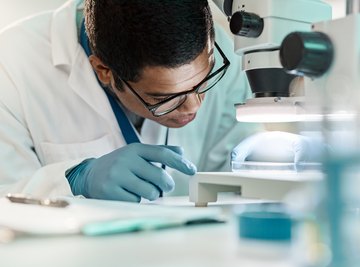
There are more ribosomes in each cell of the human body than any other type of cellular organelle, according to Ohio State University. The main function of ribosomes is to produce proteins that are used both inside the cell and sent outside the cell. Without ribosomes, the human body would not be able to produce the proteins it needs to survive and metabolism would come to a grinding halt.
Amino Acid Assembly
Ribosomes are responsible for assembling amino acids and proteins in cells, according to St. Edward’s University. The more ribosomes a cell has, the more proteins it produces. Ribosomes read what’s called RNA, the molecular "instructions" for producing protein, and follow these cellular instructions to produce proteins. This process of reading information found in RNA to produce proteins is called translation, according to the University of Wisconsin La Crosse.
Free-Floating Ribosomes
Free-floating ribosomes float within the cytoplasm of cells and are not attached to any particular structure, according to Ohio State University. These ribosomes are responsible for making structural proteins like the ones needed to produce hemoglobin. In cells that grow rapidly such as pancreas and brain cells, ribosomes are found in small clusters of five to 10 within the cytoplasm. These groups are called polysomes and polyribosomes. In addition, free-floating ribosomes are also responsible for producing proteins that help make up the solution of the cytoplasm.
Ribosomes Attached to Endoplasmic Reticulum
Ribosomes that are attached to the endoplasmic reticulum are responsible for producing enzymes like digestive enzymes, according to Ohio State University. In addition, ribosomes attached to the endoplasmic reticulum make the proteins that are eventually used for cell membranes.
Fun Facts
Ribosomes are made of 70 different types of protein and four different types of nucleic acid molecules, according to the History of the Universe website. Ribosomes are extraordinary organelles -- they can add between three and five amino acids each to a new protein every second. In animal cells, all the ribosomes in the cell add approximately 1 million amino acids together to growing proteins every second. Bacteria cells can contain tens of thousands of ribosomes and animal cells can have as much as a few million ribosomes, according to Georgia State University.
References
Resources
About the Author
Carolyn Gray started writing in 2009. Her work history includes line and staff management in the Finance and Controller's Department of New York Telephone and NYNEX. Gray has a Bachelor of Arts in government from Clark University and a Master of Business Administration from New York University's Stern School of Business in Management and Organization Behavior.
